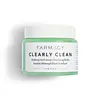What's inside
What's inside
 Key Ingredients
Key Ingredients

 Benefits
Benefits

 Concerns
Concerns

 Ingredients Side-by-side
Ingredients Side-by-side

Caprylic/Capric Triglyceride
MaskingGlycerin
HumectantWater
Skin ConditioningPolyglyceryl-3 Methylglucose Distearate
EmulsifyingPolysorbate 80
EmulsifyingCetearyl Olivate
Sorbitan Olivate
EmulsifyingHydroxyacetophenone
AntioxidantPhenoxyethanol
PreservativeAcrylates/Beheneth-25 Methacrylate Copolymer
Mangifera Indica Seed Butter
Skin ConditioningSalvia Hispanica Seed Oil
MoisturisingLactobacillus/Acerola Cherry Ferment
Skin ProtectingLactobacillus/Pumpkin Fruit Ferment Filtrate
Skin ConditioningSaccharomyces/Rice Ferment Filtrate
Skin ConditioningCamellia Sinensis Seed Oil
HumectantCandida Bombicola/Glucose/Methyl Rapeseedate Ferment
AntimicrobialSodium Hydroxide
BufferingHelianthus Annuus Seed Oil
EmollientBeta-Carotene
Skin ConditioningCapsanthin/Capsorubin
Cosmetic ColorantButylene Glycol
HumectantTocopherol
AntioxidantLeuconostoc/Radish Root Ferment Filtrate
AntimicrobialOlea Europaea Fruit Oil
Masking1,2-Hexanediol
Skin ConditioningPolyglyceryl-3 Diisostearate
EmulsifyingAscorbyl Palmitate
AntioxidantRosmarinus Officinalis Leaf Extract
AntimicrobialAscorbic Acid
AntioxidantCaprylic/Capric Triglyceride, Glycerin, Water, Polyglyceryl-3 Methylglucose Distearate, Polysorbate 80, Cetearyl Olivate, Sorbitan Olivate, Hydroxyacetophenone, Phenoxyethanol, Acrylates/Beheneth-25 Methacrylate Copolymer, Mangifera Indica Seed Butter, Salvia Hispanica Seed Oil, Lactobacillus/Acerola Cherry Ferment, Lactobacillus/Pumpkin Fruit Ferment Filtrate, Saccharomyces/Rice Ferment Filtrate, Camellia Sinensis Seed Oil, Candida Bombicola/Glucose/Methyl Rapeseedate Ferment, Sodium Hydroxide, Helianthus Annuus Seed Oil, Beta-Carotene, Capsanthin/Capsorubin, Butylene Glycol, Tocopherol, Leuconostoc/Radish Root Ferment Filtrate, Olea Europaea Fruit Oil, 1,2-Hexanediol, Polyglyceryl-3 Diisostearate, Ascorbyl Palmitate, Rosmarinus Officinalis Leaf Extract, Ascorbic Acid
Cetyl Ethylhexanoate
EmollientSynthetic Wax
AbrasiveCoco-Caprylate/Caprate
EmollientCaprylic/Capric Triglyceride
MaskingPolyglyceryl-10 Dioleate
EmulsifyingPolyglyceryl-6 Dicaprate
EmulsifyingSorbitan Oleate Decylglucoside Crosspolymer
CleansingHelianthus Annuus Seed Oil
EmollientMoringa Oleifera Seed Extract
Skin ConditioningCarica Papaya Fruit Extract
Skin ConditioningMoringa Oleifera Leaf Water
Skin ConditioningPentylene Glycol
Skin ConditioningGluconolactone
Skin ConditioningPolyglyceryl-6 Oleate
EmulsifyingGlyceryl Citrate/Lactate/Linoleate/Oleate
EmulsifyingSorbitan Sesquioleate
EmulsifyingPotassium Olivate
EmulsifyingGlyceryl Caprylate
EmollientPolyglyceryl-3 Caprate
EmulsifyingPolyglyceryl-4 Cocoate
EmollientSodium Chloride
MaskingButylene Glycol
HumectantWater
Skin ConditioningSodium Benzoate
MaskingMaltodextrin
AbsorbentGlyceryl Laurate
EmollientCetyl Ethylhexanoate, Synthetic Wax, Coco-Caprylate/Caprate, Caprylic/Capric Triglyceride, Polyglyceryl-10 Dioleate, Polyglyceryl-6 Dicaprate, Sorbitan Oleate Decylglucoside Crosspolymer, Helianthus Annuus Seed Oil, Moringa Oleifera Seed Extract, Carica Papaya Fruit Extract, Moringa Oleifera Leaf Water, Pentylene Glycol, Gluconolactone, Polyglyceryl-6 Oleate, Glyceryl Citrate/Lactate/Linoleate/Oleate, Sorbitan Sesquioleate, Potassium Olivate, Glyceryl Caprylate, Polyglyceryl-3 Caprate, Polyglyceryl-4 Cocoate, Sodium Chloride, Butylene Glycol, Water, Sodium Benzoate, Maltodextrin, Glyceryl Laurate
 Reviews
Reviews

Ingredients Explained
These ingredients are found in both products.
Ingredients higher up in an ingredient list are typically present in a larger amount.
Butylene Glycol (or BG) is used within cosmetic products for a few different reasons:
Overall, Butylene Glycol is a safe and well-rounded ingredient that works well with other ingredients.
Though this ingredient works well with most skin types, some people with sensitive skin may experience a reaction such as allergic rashes, closed comedones, or itchiness.
Learn more about Butylene GlycolThis ingredient is an emollient, solvent, and texture enhancer. It is considered a skin-softener by helping the skin prevent moisture loss.
It helps thicken a product's formula and makes it easier to spread by dissolving clumping compounds.
Caprylic Triglyceride is made by combining glycerin with coconut oil, forming a clear liquid.
While there is an assumption Caprylic Triglyceride can clog pores due to it being derived from coconut oil, there is no research supporting this.
Learn more about Caprylic/Capric TriglycerideHelianthus Annuus Seed Oil is the oil derived from the seeds of a Sunflower. Sunflower seed oil is non-fragrant. It is an emollient, meaning it helps to soften the skin.
Sunflower seed oil contains many fatty acids. The fatty acids found in sunflower seeds include (from highest amount to least): linoleic acid, myristic acid, palmitic acid, stearic acid, arachidic acid, oleic acid, and linolenic acid.
These fatty acids help the skin create ceramides. Ceramides play a role in repairing the skin barrier.
Helianthus Annuus Seed Oil helps moisturize the skin. This in turn helps the skin look more rejuvenated and smoother.
Sunflowers are rich in vitamin E.
Historians believe Indigenous cultures of North America domesticated sunflowers before corn. Thus they relied on sunflower oil for a variety of uses. One such use is moisturizing skin and hair.
Sunflower seed oil may not be fungal acne safe. We recommend speaking with a professional if you have any concerns.
Learn more about Helianthus Annuus Seed OilWater. It's the most common cosmetic ingredient of all. You'll usually see it at the top of ingredient lists, meaning that it makes up the largest part of the product.
So why is it so popular? Water most often acts as a solvent - this means that it helps dissolve other ingredients into the formulation.
You'll also recognize water as that liquid we all need to stay alive. If you see this, drink a glass of water. Stay hydrated!
Learn more about Water